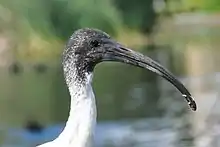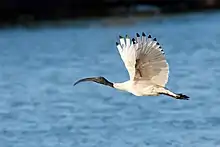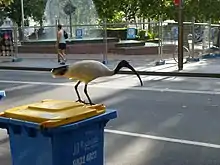Australian white ibis
The Australian white ibis (Threskiornis molucca) is a wading bird of the ibis family, Threskiornithidae. It is widespread across much of Australia. It has a predominantly white plumage with a bare, black head, long downcurved bill and black legs. While its sister species is the African sacred ibis, the Australian white ibis is a native Australian bird - contrary to urban myth, it is not a feral species introduced to Australia by people, and it does not come from Egypt.[2]
| Australian white ibis | |
|---|---|
 | |
| Scientific classification | |
| Kingdom: | Animalia |
| Phylum: | Chordata |
| Class: | Aves |
| Order: | Pelecaniformes |
| Family: | Threskiornithidae |
| Genus: | Threskiornis |
| Species: | T. molucca |
| Binomial name | |
| Threskiornis molucca Cuvier, 1829 | |
| Subspecies | |
| |
| Synonyms | |
|
Threskiornis moluccus | |
Historically rare in urban areas, the Australian white ibis has established in urban areas of the east coast in increasing numbers since the late 1970s; it is now commonly seen in Wollongong, Sydney, Melbourne, Darwin, the Gold Coast, Brisbane and Townsville. In recent years the bird has also become increasingly common in Perth, Western Australia, and surrounding towns in south-western Australia.[3] Populations have disappeared from natural breeding areas such as the Macquarie Marshes in northern New South Wales. Management plans have been introduced to control problematic urban populations in Sydney.[4][5]
Due to its increasing presence in the urban environment and its habit of rummaging in garbage, the species has acquired a variety of colloquial names such as "tip turkey"[6] and "bin chicken",[7] and in recent years has become an icon of Australia's popular culture, regarded with glee by some and passionate revulsion by others.[8]
It is known as mardungurra among the Yindjibarndi people of the central and western Pilbara.[9]
Taxonomy
It was initially described by Georges Cuvier in 1829 as Ibis molucca. It is considered part of a superspecies complex with the sacred ibis (T. aethiopicus) of Africa, and the black-headed ibis (T. melanocephalus) of Asia. Its status in the complex has vacillated over the years. Many older guidebooks referred to the bird as a species T. molucca, until a comprehensive review of plumage patterns by Holyoak in 1970. Holyoak noted the three species' similarities and that the Australian taxon resembled T. aethiopicus in adult plumage and T. melanocephalus in juvenile plumage. He proposed they all be considered part of a single species T. aethiopicus. This was generally accepted by the scientific community until Lowe and Richards's assessment of plumage in 1991.[10] They again recommended the recognition of molucca at species level. This was followed by chromosome study which highlighted each of the three species having a different karyotype.[11] The Australian white ibis has been considered a full species by most authorities since then.[12]
Subspecies
Three subspecies are recognised:
- T. m. molucca of eastern Malesia and Australia, is the nominate subspecies.
- T. m. rugalaeus of Australian Capital Territory (ACT) [10]
- T. m. pygmaeus (Solomons white ibis) is a dwarf form found on the Solomon Islands that has been considered a separate species at times.[10]
Description


The Australian white ibis is a fairly large ibis species, around 65–75 cm (26–30 in) long and has a bald black head and neck and a long black downcurved beak, measuring over 16.7 cm (6.6 in) in the male, and under in the female. There is some sexual dimorphism in size, as the slightly heavier male weighs 1.7–2.5 kg (3.7–5.5 lb) compared to the 1.4–1.9 kg (3.1–4.2 lb) female.[13] As a comparison, the American white ibis generally attains 1 kg (2.2 lb) in weight.[14] The body plumage is white although it may become brown-stained. Inner secondary plumes are displayed as lacy black "tail" feathers. The upper tail becomes yellow when the bird is breeding. The legs and feet are dark and red skin is visible on the underside of the wing. Immature birds have shorter bills.[15] The head and neck are feathered in juveniles.
The call is a long croak.[15]
The Australian white ibis reaches sexual maturity in three years,[13] and can reach twenty-eight years of age.[6]
Distribution

The Australian white ibis is widespread in eastern, northern and south-western Australia. It occurs in marshy wetlands, often near open grasslands and has become common in Australian east-coast city parks and rubbish dumps in the urban areas of Wollongong, Sydney, Perth, the Gold Coast, Brisbane and Townsville. Historically it was rare in urban areas - the first visits were noted after drought drove birds eastwards in the late 1970s, and there were no breeding records in Sydney until the 1980s.[16]
The Macquarie Marshes in north-western New South Wales was one of the main areas for breeding, but none has been reported breeding there since 2000, from 11,000 pairs in 1998.[6] The species is absent from Tasmania.[17]
Urban population
The species has been able to colonise urban areas by reducing its fear response when in close proximity to humans, and by significantly widening its suite of food items to include human refuse - strategies that other closely-related species such as the straw-necked ibis and the spoonbills have not replicated.[2]
Questions surrounding the origins of recent highly urbanised and closely human-habituated populations of the species are complicated by the establishment of free flying exhibit flocks of formerly captive birds at a number of zoos and wildlife parks, including Sydney's Taronga Zoo, which first acquired birds for this purpose around 1971.[16][2] A 1973 ABC TV report noted Taronga's by then well-established "liberty flock" was breeding locally, unlike natural populations, which at that time were only known to fleetingly visit the urban area and not breed there.[18]
The resident Taronga flock nested in exotic Canary Island date palms, and was notably very closely habituated to people; approaching them at close quarters, feeding from rubbish bins and scavenging food from outdoor dining areas. These previously undocumented behaviours became closely associated with the urban Sydney flocks that emerged from around 1980 onwards, directly across the harbour in the Royal Botanic Gardens and the Sydney CBD, and further afield in the Centennial Parklands.[13][2]
The relationship between birds originating from the Taronga flock and any influx of inland birds into Sydney is poorly known, but it is speculated that human-habituated flocks originating from the zoo may have encouraged some visiting flocks to stay in Sydney, with the two populations likely merging to some degree.[16] Resident Sydney birds may have influenced newcomers fleeing from inland drought to adapt to new food sources in the city and to accept close proximity to humans.[2] Other free-flying exhibit populations were similarly established at Healesville Sanctuary in Victoria and at Tidbinbilla in the ACT, both of which mirrored the Taronga example by appearing to serve as population nucleation points.[16] Healesville birds also seeded a free-flying population at Currumbin Wildlife Sanctuary in Queensland.[2]
The urban population further increased after a further period of inland drought in 1998.[6] The first big colony set up in the Sydney suburb of Bankstown and started to cause anxiety in the local community. It is estimated the colony was the largest outside the Macquarie Marshes, their natural breeding wetland in inland NSW.[6]
Invasiveness

There has been debate in recent years over whether to consider them a pest or a possibly endangered species. Birds in tourist areas of Sydney, such as Darling Harbour, the Royal Botanic Gardens, and Centennial Park, have been a problem due to their strong smell. Populations in the latter two areas have been culled.[19]
The birds have also come to be regarded as a problem species in Victoria as a result of their scavenging activities, scattering rubbish from tips and bins in the process. They are even known to snatch sandwiches from picnickers. Such behaviour, together with their propensity to build nests in "inappropriate" places, and competition with captive animals, led to surplus birds being relocated from Healesville Sanctuary to Sale. However, the birds returned in a few days.[20]
Behaviour

.jpg.webp)
Feeding
The Australian white ibis' range of food includes both terrestrial and aquatic invertebrates and human scraps. The most favoured foods are crayfish and mussels, which the bird obtains by digging with its long bill.
Breeding
Breeding season varies with the location within Australia, generally August to November in the south, and February to May, after the wet season, in the north. The nest is a shallow dish-shaped platform of sticks, grasses or reeds, located in trees and generally near a body of water such as river, swamp or lake. Ibises commonly nest near other waterbirds such as egrets, herons, spoonbills or cormorants. Two to three dull white eggs are laid measuring 65 mm × 44 mm.[21] The clutch is then incubated for 21–23 days. Hatchlings are altricial, that is, they are naked and helpless at birth, and take 48 days to fledge.[13]
References
- BirdLife International (2016). "Threskiornis moluccus". IUCN Red List of Threatened Species. 2016: e.T22697519A93618773. doi:10.2305/IUCN.UK.2016-3.RLTS.T22697519A93618773.en.
- Contributor (31 October 2020). "Secrets of the Ibis: The surprising real reason 'bin chickens' took Sydney by storm". The Sydney Sentinel. Retrieved 31 October 2020.
- "Archived copy" (PDF). Archived from the original (PDF) on 16 March 2016. Retrieved 11 February 2017.CS1 maint: archived copy as title (link)
- Australian White Ibis City of Canterbury Bankstown. Retrieved 22 December 2016.
- Management Plan for Australian White Ibis in the Bankstown Local Government Area, 2012 Retrieved 22 December 2016.
- "Ibis invasion". Australian Broadcasting Corporation. Archived from the original on 16 November 2007. Retrieved 22 November 2007.
- ‘Bin chicken’ set to be Australia’s 2017 bird of the year news.com.au 22 November 2017. Retrieved 7 September 2018.
- Allatson, P and Connor, A. The rise of the ibis: How the 'bin chicken' became a totem for modern Australia ABC News, 7 September 2018. Retrieved 7 September 2018.
- Juluwarlu Aboriginal Corporation (2005). Garruragan: Yindjibarndi Fauna. Juluwarlu Aboriginal Corporation. p. 32. ISBN 978-1-875946-54-9.
- Lowe KW, Richards GC (1991). "Morphological Variation in the Sacred Ibis Threskiornis aethiopicus Superspecies Complex". Emu. 91 (1): 41–45. doi:10.1071/MU9910041. Retrieved 14 June 2008.
- de Boer LE, van Brink JM (1982). "Cytotaxonomy of the Ciconiiformes (Aves), with karyotypes of eight species new to cytology". Cytogenet. Cell Genet. 34 (1–2): 19–34. doi:10.1159/000131791. PMID 7151490.
- Christidis L, Boles WE (2008). Systematics and Taxonomy of Australian Birds. Canberra: CSIRO Publishing. p. 113. ISBN 978-0-643-06511-6.
- Legoe C, Ross G, eds. (April 2007). "Wild about ibis: living with urban wildlife" (PDF). Department of Environment and Climate Change, New South Wales - website. Department of Environment and Climate Change NSW. Archived (PDF) from the original on 27 July 2008. Retrieved 15 June 2008.
- Hancock & Kushan, Storks, Ibises and Spoonbills of the World. Princeton University Press (1992), ISBN 978-0-12-322730-0
- Simpson K, Day N, Trusler P (1993). Field Guide to the Birds of Australia. Ringwood, Victoria: Viking O'Neil. p. 54. ISBN 978-0-670-90478-5.
- "Is Taronga Zoo responsible for Sydney's prolific bin chicken population?". Australian Broadcasting Corporation. 7 August 2018. Retrieved 6 October 2020.
- http://birdlife.org.au/bird-profile/australian-white-ibis
- Weekend Magazine: Ibis (1973), retrieved 6 October 2020
- "Ibises–cull them or cuddle them?". The Sydney Morning Herald. 5 October 2006. Retrieved 5 November 2006.
- Temby, Ian (June 2003). "Problems caused by the Australian White Ibis" (PDF). State of Victoria Department of Sustainability and Environment. Archived from the original (PDF) on 16 August 2008. Retrieved 29 June 2008.
- Beruldsen, Gordon (2003). Australian Birds: Their Nests and Eggs. Kenmore Hills, Qld: self. p. 177. ISBN 978-0-646-42798-0.
External links
 Media related to Threskiornis molucca at Wikimedia Commons
Media related to Threskiornis molucca at Wikimedia Commons Data related to Threskiornis moluccus at Wikispecies
Data related to Threskiornis moluccus at Wikispecies
